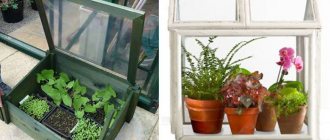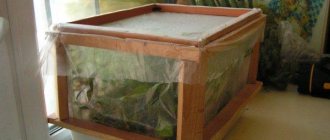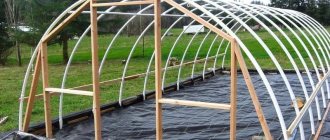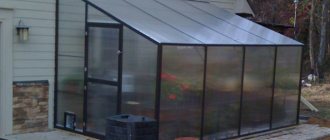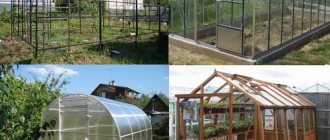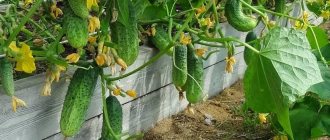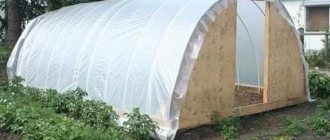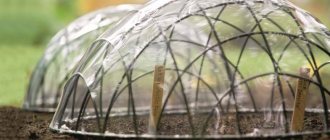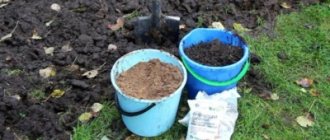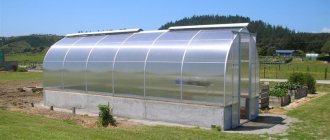Option #1 – custom-made mini-greenhouses
Thus, the IKEA company produces its series for the home - Sochker. Of course, this is more of a decorative device and a good feature for the interior, but the plants in such a “house” really feel good: there is a lot of space, it opens upward, and there are environmentally friendly materials. And assembling such things is a special holiday for the soul.
Let's add a decorative effect:
And the box itself for such a filling can be made according to this principle:
How to make a mini greenhouse yourself
If you can’t spend money on ready-made structures, then you can try to make a mini-greenhouse yourself, using materials that are in every home. What to make a mini greenhouse from:
- The most simplified option, which is often used by all summer residents and begin to harvest seedlings from the end of winter, is ordinary boxes covered with glass.
- Large aquariums and mini-greenhouses made from transparent plastic bottles are also used.
Method with plastic bottles:
- This method requires a lot of space and takes up almost all the window sills.
Advice. It is better to use a greenhouse made in the form of a display case.
- A rack is assembled for them, with the dimensions of a window opening and a shelf made of transparent plexiglass.
- A fluorescent lamp or phytolamp is suspended above the mini-structure.
- The opening is curtained with ordinary plastic film.
Advice. To protect the seedlings from direct sunlight, the windows are curtained with blinds.
Greenhouse showcase
How to make a mini greenhouse display case yourself:
- These designs are most often found autonomous.
They are covered on all sides with translucent material, and the front part is made hinged or sliding.
Option #2 – design from the USSR
And this “smart” structure is from no less smart books from the times of the USSR. There are as many as 12 drawers inside, 8 on the lower tier, and 4 on the upper. The whole concept of such a mini-greenhouse is a green conveyor: in the first four boxes on the lower tier, where there is more shade, the seeds have just been sown, on the second floor they have already sprouted, and on the top, where there is the most light, in a couple of days you can start harvesting .
This idea is also from the well of Soviet inventors:
GREENHOUSES FOR YOUNG PLANTS
For young plants, simple insulating greenhouses are usually arranged. They also often root cuttings, germinate fern spores, grow orchid cuttings, etc. Old aquariums can be used as such a greenhouse.
You can make a simple greenhouse from glass, plastic, or even from a large plastic bag in which you can temporarily put small indoor plants. Plexiglas insulators are good.
First you need to determine the size of the greenhouse and cut out the glass. There is no need to take very thick glass - the greenhouse will be too heavy. When marking, the side walls are made two thicknesses of glass wider than the bottom, otherwise there will be a gap between the side and end glass. The edges of the glass are matted with a sharpening stone or emery stone. The width of the matted edge is 8-10 mm. The top edge is not matted.
The glass is glued together with BF-2 glue, tied with threads and left to dry for 24 hours. Then the greenhouse is covered with paper pads 20 mm wide and the inner corners are filled with glue. After 10 days, the simplest greenhouse is ready.
Due to the small volume of the simplest insulator, sharp temperature fluctuations are possible in it, which can have a detrimental effect on young plants.
It is best to install a greenhouse for young plants away from the window and provide additional light. two 20-watt or one 30-watt fluorescent lamps are enough. The top of the insulator is covered with glass, which is removed once a day for ventilation.
It is useful to place sphagnum moss at the bottom of such a greenhouse for indoor plants. Moss, evaporating a significant amount of water, creates extremely favorable conditions for plant growth. In addition, moss is sterile, and therefore the risk of disease development is minimized.
Due to the high air humidity in the insulator, the substrate dries out very slowly, so young plants are rarely watered.
Otherwise, caring for plants in a simple indoor greenhouse comes down to maintaining cleanliness and removing dying leaves.
Option #4 – construction from old cans
Here's how to make the most basic mini-greenhouse from a white can or barrel:
- Step 1. Take a can, place it horizontally on the ground and cut three large holes in it so that it is convenient to pour soil there and plant plants.
- Step 2. Now we take double film or tarpaulin and fasten it on top with four screws. A tarpaulin is better, because... it is heavy and the wind cannot blow it around.
- Step 3. Place soil and sow seeds.
All that remains is to water and observe the seedlings.
Using scrap materials
Building a greenhouse with your own hands involves certain financial costs. But they can be reduced to nothing if you build it from scrap materials. Old cans, plastic bottles, a broken umbrella or grandma's suitcase - everything will be used.
Old cans and barrels can be found in any household. They can be used to make an excellent greenhouse. To do this, wash the container and carefully cut windows in its side parts. It is important not to disturb the stiffeners, if any. You can cover the plants with a thick film, which is attached to the barrel with double-sided tape.
Option #6 – hydroponic mini-greenhouse
It is convenient because it requires a minimum of soil, and it can be placed anywhere – even on concrete. And if necessary, reschedule.
So, here's how to make one yourself:
- Step 1. Create a flat base. It just needs to be perfectly even - so that nutrients and water are then distributed evenly through the pipes, and this is very important! Any distortion, even a subtle one, will produce an uneven harvest, and some plants will even die.
- Step 2. Take ordinary PVC water pipes and make holes in them at the distance from each other at which it is usually recommended to plant your chosen crop in open ground.
- Step 3. Fix the pipes in rows there so that it is convenient for you to work with them. Check the horizontal position again using a building level.
- Step 4. Pass a thin hose with holes through each of the pipes - this is the future drip irrigation, directed directly to the roots. Connect the hose to a pump system or a homemade water barrel that is pressurized (same weight on the lid).
After all, cover the whole thing with film. There you go!
Check the water level (every day) and soil pH (once a week) periodically. If you have pests on your site or the planted crop is constantly sick in the open ground, then be sure to cover the greenhouse with a mosquito net - especially if you remove the film on hot days. The fact is that both caterpillars and pests that bothered you before will still find your hydroponics, and therefore it is better to protect your plants from them in advance.
You can also make real greenhouses from glass teapots and vases - a wonderful decoration for the garden!
How to choose a ready-made home greenhouse
When choosing a ready-made home greenhouse, you should adhere to the basic rules, namely:
- pay attention to the material from which the greenhouse is made: it must be durable, transmit light well and be environmentally friendly;
- consider the size of the finished structure: it should fit in the place in your house where you plan to place it.
You will be interested to know how and from what to make a greenhouse for seedlings with your own hands.
Following all the necessary recommendations from experts will allow you to grow high-quality vegetables and herbs in your own apartment throughout the year. In this case, you just need to choose the type of greenhouse that fits the dimensions of your home.
Option #7 – greenhouse inside a greenhouse
This is a wonderful setup for protecting tender seedlings right inside the structure:
And this is a heated greenhouse for the windowsill:
Hi-Tech: technologies of the future
What you see is not screenshots from some science fiction film about an apartment of the future, where even greens for soup grow right in the kitchen in some kind of space device. These are actually real structures!
NIWA
So, one of the most famous inventions is the NIWA mini-greenhouse, developed by Nazaryuk and Morila from the city of San Francisco. Such a baby is capable of completely independently caring for any plant - maintaining its optimal temperature, humidity and light. All you need to do is plant the seeds and occasionally add water to the tank.
This is not only an interior decoration, but also sometimes the only way to grow a particularly capricious plant. How well the plant feels and how it grows can be seen directly from your smartphone. From it you can remotely control the necessary parameters. And the dimensions are only 46 cm long and 21 cm wide, and almost a meter high.
Already this year, the structures can be found on sale in Russia, and they cost approximately the same as a smartphone itself.
Smart Hetb Garden
Another similar development is Smart Hetb Garden based on the Click & Grow system. It automatically feeds the plants with moisture and fertilizers. This device runs on batteries, and to grow a certain variety you need to purchase a ready-made cartridge with that variety.
At first glance, this is a stylish plant pot. But in fact, such a mini-greenhouse consists of as many as six automatic interchangeable pots. Each of them has a special built-in lamp for illumination. The height of the lamp can be adjusted, covered with blinds and thus control the amount of light for the seedling. Moreover, such lighting can completely replace the sun for a plant.
There is no soil in this design - instead there is a water pump with a nutrient mixture for the roots. Those. The principle of hydroponics is fully involved here. You can grow both greens and berries, flowers and even fruits and vegetables.
Aerogarden
This is also a good home structure that allows you to grow something all year round. A person will have to spend no more than 10 minutes a month on monitoring plants, as the manufacturer assures. Cherries, fresh herbs, flowers - and any other vitamins.
Special lamps are built here that accelerate the growth and development of the plant. A smart microprocessor monitors all the needs of the plant, and a special system supplies oxygen directly to the roots of the plants. Greens can already be harvested 4 weeks after planting, and cherry tomatoes after 14 weeks. It turns out that after planting in such a unit, plants begin to develop 5 times faster.
Many people like this mini greenhouse because of its stylish new design. But there is no way to buy such a gadget in Russia - you can only order it from abroad. Although there is no doubt that soon craftsmen will learn to make something similar and cheaper.
Groubox: It's all about the rotation
But this is a complete miracle of technology. It was invented by an inventor from Canada. It is a wheel that occupies only 2 square meters of area. The plants are hydroponically and constantly rotating. The space savings are amazing!
Rotation also has its own meaning. So, thanks to changing gravity, moisture and nutrients are better distributed throughout the soil.
This thing can even be placed in the pantry. You can grow up to 30 kg of greens or lettuce per month, which is enough for a large family.
Types of home greenhouses
A miniature greenhouse in a city apartment can be constructed without much difficulty. The manufacturing technology will depend on the type of greenhouse that you want to build at home, so you need to familiarize yourself in more detail with the basic designs of home greenhouses. The main types of home greenhouses can be: a classic greenhouse, a thermobox, a portable structure, a greenhouse in the form of a cabinet, etc.
Did you know? The largest number of greenhouses in the world is located in Holland. Their total area in the country is 10.5 thousand hectares.
Classical
A classic greenhouse is a miniature copy of a greenhouse with a gable roof. The first step is to assemble the frame, and then cover it with a special material, which must have light-conducting and heat-insulating properties.
When constructing the frame, you should use plastic or metal pipes, as well as wooden beams. Synthetic mesh, film, glass can be used as a coating. Some gardeners use plastic bottles.
Greenhouse-cabinet
Mini-greenhouses, which have the shape of a shelf or cabinet, can contribute to the comfortable development of plants in an apartment or country house. Despite its small area, this type consists of many tiers and can accommodate a large number of plants, which is the optimal solution for a city apartment. The main advantage of this type of greenhouse is mobility. In summer, you can grow capricious flowers in them, for example, petunia.
Growbox
It will be more difficult to implement such a structure at home than a classic greenhouse or greenhouse-cabinet. This is due to the fact that this design is a smart automated system. This type of structure for growing plants allows you to regulate not only the microclimate, but also maintain favorable development conditions.
The growbox is equipped with a lighting, ventilation, humidification, air filtration system, as well as a carbon dioxide saturation complex, and its internal coating is finished with reflective material. Growboxes come in the following types: standard, growcompact and stealth. The operating mode depends on the varieties of plants that are going to be grown in the greenhouse.
Thermobox
The thermobox can be used for growing seedlings, vegetables and herbs at home. It is recommended to place it on the balcony, as it can easily withstand temperature changes. Automatic support of an optimal microclimate is the main advantage of this type of greenhouse. The system can be configured to automatically supply all the necessary microelements, watering, and also regulate the temperature.
Aeroponic greenhouses
This type of equipment is a high-tech product based on aeroponics. The process of growing plants occurs without human intervention and without the use of soil. This method is based on a system of periodically spraying a mineral solution onto the hanging root system. The plant receives all the necessary amounts of nutrients.
